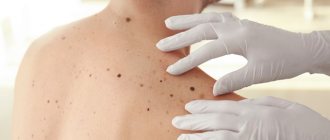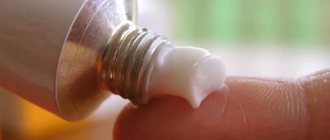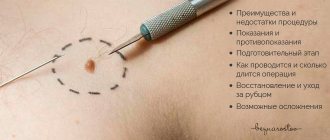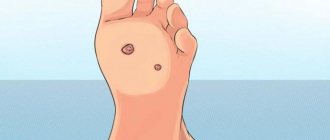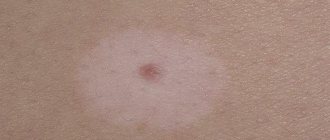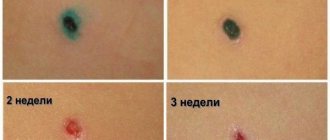Publication date: July 03, 2014.
Now many people decide to undergo a procedure such as mole removal. After all, they are not always pretty, and sometimes cause discomfort. But what are the consequences of removing moles? Will there be a huge scar left, will the mole grow again? First, let's figure out what neoplasms can appear on human skin?
Advantages and disadvantages of laser removal
Ablative laser is a method of getting rid of skin defects, used on all areas of the skin. The method is safe, the effect is achieved through layer-by-layer evaporation of pigmented cells. Advantages of the method:
- bloodlessness of the laser beam (the capillaries are sealed, bleeding is excluded);
- contactless procedure;
- sterility (bactericidal effect of laser);
- accuracy of impact on pigmented cells;
- minimal trauma to the skin due to the small diameter of the beam, controlled depth of exposure;
- possibility of carrying out on the face, open areas of the body;
- possibility of treating patients with a pacemaker;
- absence of scars at the site of removal of defects;
- safe for treating children and adults;
- rapid skin regeneration stimulated by laser;
- painless procedure with local anesthesia;
- lack of special training;
- the ability to remove a nevus in 1 visit to the doctor, unlike the popular celandine;
- no relapses.
The achievements of modern medicine in the field of cosmetology have a number of undeniable advantages over traditional medicine recipes prepared at home. The only drawback of laser technology is the inability to examine a removed nevus for cancer cells, conduct histology, and the inability to treat pregnant women. Otherwise, the method is popular, effective, and does no harm.
The cost of the procedure depends on the size of the defect and the number of formations that the patient wants to remove at one time.
Mole removal price
The initial consultation with a cosmetologist at the REDNOR cosmetology centers on the issue of mole removal during the procedure on the day of the consultation is FREE.
| Procedure/zone | Price, in rubles |
| Initial doctor's appointment before treatment | 900,00 |
| Removal of a benign formation, per 1 mm diameter (eyelid) | 900,00 |
| Laser removal of benign formations (nevi, moles, etc.), per 1 mm diameter (face) | 800,00 |
| Laser removal of benign formations (nevi, moles, etc.), per 1 mm diameter (body) | 500,00 |
| Infiltration anesthesia, 1 ampoule | 400,00 |
all prices in the section Laser cosmetology prices
- All Promotions
- Consultation
- 900 rub. 0 rub.1
- 1 If the procedure is carried out on the day of consultation, see the conditions
- Sign up
Preparing for removal
Preparation for the procedure consists of:
- identifying contraindications;
- taking anamnesis;
- dermatoscopy - visual inspection of the formation under a magnifying glass for the presence of uneven edges, uneven coloring, symmetry, and depth of pigment.
In the absence of contraindications, the final decision on the method of removing skin defects remains with the patient; if there are contraindications, the doctor recommends a treatment method suitable for the patient and postpones the procedure to a later date.
Anamnesis collection consists of interviewing the patient. The doctor finds out how long ago the mole was formed, what is the dynamics of growth, color changes, and whether there are cases of melanoma in the patient’s immediate environment.
Doctors insist on removing nevi that are regularly exposed to strong sunlight. Localized on the face, neck, décolleté, in places of greatest friction with clothing: belt, groin, armpits, feet, palms, scalp, chin, nose. The patient’s motivation to remove the nevus or not is a matter of aesthetics, preventing the formation from degenerating into a malignant tumor.
When to go to the surgeon
First you need to understand in what cases and why you need to remove moles. There are ordinary moles, they do not cause any harm to health. They may, perhaps, spoil the appearance a little. There are also nevi - malignant moles. You can expect trouble from them if you don’t remove them in time. Reasons for nevus removal:
- Causes itching, discomfort or pain;
- Changes size or shape;
- Color has changed;
- Hairs fall out of the mole;
- The surrounding skin turns red;
- There are strange discharges;
- It is located in a place where it can easily be caught by clothing;
- Located on an area of the body not covered by clothing.
If you have any of the above, immediately before the laser mole removal procedure, consult your doctor for advice to minimize the consequences.
How does it happen and does it hurt?
Before laser exposure, the skin is treated with antiseptic agents, anesthetized locally, externally, by injection, so that the patient does not feel pain. Only short-term minimal discomfort from the process remains.
At the second stage, the dermatologist directs the laser beam at the nevus, limiting the impact to the borders of the mole along the perimeter, the depth of the pigmented cells. The high accuracy of the spectrum radiation allows you to avoid the impact of the device on healthy cells around the nevus, and to remove small formations throughout the body, located on the eyelids, along the ciliary edge. The laser simultaneously seals the blood vessels, evaporates the pigmented layer of skin, and promotes coagulation of the injured area.
The procedure takes a few seconds per mole. The number of moles to be removed during one visit to a medical clinic is determined by the doctor. If there are a large number of nevi, the patient undergoes the procedure again.
Laser burns out other dangerous benign tumors, papillomas, warts caused by HPV, along with other modern methods of burning out skin growths: liquid nitrogen, radio wave method - surgitron, using surgery.
How does laser removal work?
To understand how laser nevus removal occurs, you need to understand the principle of exposure to rays during the procedure. A laser wave of a certain magnitude, directed at the mole, removes the dermis layer by layer, performing excision. The high precision of the laser beam “evaporates” the contents of the mole without damaging the adjacent skin. Correctly calculated by the doctor, the beam force “seals” the vessels in contact with the operation site, which avoids bruising and inflammation.
Under laser exposure, surface skin cells begin to divide more actively, and regeneration accelerates. After a few days, the burned area where the nevus was located is completely renewed. A safe procedure for laser removal of moles takes a few minutes, without causing pain to the patient. During laser operation, a slight burning odor may be felt.
The thin red crust that appears quickly disappears if you apply a healing cream prescribed by the doctor. At the request of the patient, parts of the tumor can be submitted for histological examination to ensure that it is benign. At the end of the removal process, the area of skin on which the procedure was performed requires special care. You should not sunbathe in the sun for some time, especially if it was an open area on the neck or face.
- Warm up before training at home
- Thermal protection for hair - which is better when styling with an iron or hairdryer
- Facial skin care at home. How to do it right
Post-procedure care
After treatment with a laser beam, a crust forms at the site of radiation, which the doctor treats with a thick solution of potassium permanganate and iodine. Treatment of the wound after removal of a mole with a high-frequency laser is not required if the formation is small in size. The doctor applies a bandage made of sterile materials to the sites of removed large nevi. On the second day, the spots are treated morning and evening with Bepanten cream/ointment and applied with a cotton swab for three days. After large scabs come off, spots of young skin are treated with scar creams and contractubex to avoid aesthetic complications. The patient must take precautions so as not to damage the integrity of the crust or tear it off ahead of time, so that the recovery process is quick and painless.
The scab should go away on its own, usually 7-10 days after the procedure. The wound should not be wetted on the first day after the procedure, steamed, scratched, or smeared with cosmetics during the healing period. Regeneration processes occur under the crust; preserving it until spontaneous peeling means preventing infection of young skin by microorganisms and fungi. Infection will complicate the healing process, add problems in the form of suppuration, redness, and itching. Any symptoms of infection should be reported to your doctor immediately.
With proper care and following the doctor’s recommendations, no traces remain at the site of the removed nevus, and pigmentation does not return. In place of large moles, there is a possibility of the formation of colorless spots that do not disturb the overall aesthetics; small moles do not leave marks on the skin.
The area with removed pigmentation is sensitive to solar radiation; until the skin becomes resistant to hyperpigmentation, doctors do not recommend sunbathing in a solarium; they insist on using a protective cream when going outside.
Rehabilitation: skin care
After laser removal of a mole, a wound remains. Depending on the size of the wound surface, healing lasts 1-3 weeks. The crust that appears then falls off, leaving behind a pink spot. The new skin retains its color from three weeks to six months. A spot on the skin up to 1 cm after time cannot be distinguished from healthy areas. If the wound was more extensive, then after healing there will be a light area on the surface of the skin. This effect occurs due to a lack of connective tissue, resulting in its replacement with scar tissue.
For two weeks after removal of the tumor, you should adhere to the following rules:
- do not engage in intense physical activity;
- ensure that the skin is not exposed to hypothermia or overheating;
- exclude solarium, bathhouse and sauna;
- do not remove the crust from the wound surface;
- avoid contact with chemicals (household);
- do not treat with alcohol solutions;
- Avoid rubbing the wound with a towel.
Your doctor will recommend how to care for the wound and prescribe an antiseptic for treatment.
How long does it take for a mole to heal after laser?
The crust at the site of mole removal disappears a week after the procedure; cosmetics can be applied to young pink skin, avoiding damage to the skin in the area affected by the laser. If it is necessary to remove a large number of moles, you can undergo a repeat procedure after a week. Reviews from patients say that after 4 months there is not the slightest hint of mole removal left on the skin, the normal pigmentation of the skin is evened out.
What types of skin tumors are there?
The most common types of skin formations are:
- Moles. Pigmented neoplasms of various colors (black, brown, flesh-colored). They can be either flat or raised above the skin.
- Papillomas. Convex formations have a brown or dark tint. They differ in their viral nature and reduce immunity.
- Warts. Nodular or papillary-like projections on the skin. Usually caused by human papillomatosis viruses, they can be transmitted through contact with a sick person.
- Condylomas. A type of wart that occurs on the genitals. Transmitted sexually with the papillomatosis virus.
Removing each type of tumor is a responsible process that must be performed by professional specialists. Attempts on your own can lead to serious negative consequences for human health.
Contraindications, possible consequences
Contraindications to laser removal of nevi:
- viral/infectious diseases in the acute stage;
- tendency to form colloidal scars;
- fresh tan;
- rash, dermatitis, violation of the integrity of the skin;
- pregnancy;
- suspicion of the presence of malignant cells in the mole;
- menstruation.
The consequences of laser removal of various types of moles boil down to improper care after surgery. With premature excision or displacement of the crust during the healing process, microorganisms, moisture, and cosmetics enter the wound, and a scar may form. If the patient goes out into the sun earlier than the period recommended by the doctor, persistent pigmentation forms on the young, delicate skin.
Removing moles in unsterile conditions by an unqualified specialist carries the risk of serious consequences: burns of healthy skin, incomplete removal of pigmentation, scar formation, wound infection, bleeding, degeneration of a nevus into an oncological neoplasm.
What moles can be removed?
It is not always possible to remove moles. If the formation is not injured, is not accompanied by growth, peeling and other alarming symptoms, it is not recommended to remove the stain. The danger of removing moles without serious indications is the risk of developing negative consequences and complications after surgery.
Safe birthmarks have the following characteristics:
small diameter;- the formation is flat, protrudes slightly above the surface of the skin;
- color from pink to brown;
- accompanied by hair growth (not always);
- have a uniform color.
Safe nevi include spots no larger than 5-7 mm in size. In this case, the formations do not manifest themselves in any way and are not accompanied by growth and changes in structure.
Nevi with suspected danger:
- formations more than 10 mm in diameter;
- acquired spots that appeared in adulthood;
- moles that change color, shape, size.
If there are birthmarks larger than 10 mm on the body, it is important to carefully monitor their condition. Medical attention should be sought if the following symptoms develop:
- The formation increases in size and has asymmetrical edges. Birthmarks that are present in a child from birth, in most cases, are not dangerous. Attention should be paid to acquired formations without clear boundaries.
- A feeling of itching and burning appears - these signs may indicate the degeneration of a mole into a malignant formation.
- The surface of the stain becomes smooth and glossy.
- The mole cracks, dries out, and dots or stripes of a darker shade appear on it.
- A wet surface appears.
- The structure of education becomes knotty.
- Redness of the contour of the spot is another alarming sign that should not be ignored.
- Loss of hair growing in the area of the nevus or, conversely, its appearance.
In addition to the signs described above, malignant birthmarks are accompanied by sudden softening, the appearance of pink dots or pigmentation around the nevus, and increased vertical growth of the formation. It is impossible to diagnose pathology on your own. The nature of the nevus can only be determined using special tests. It is difficult even for an experienced doctor to make a diagnosis based on external signs.
Moles should be removed exclusively in a hospital setting after a comprehensive examination of the patient and diagnosis. The use of folk remedies is unacceptable, as it often causes serious consequences that are dangerous to the life and health of the patient.

